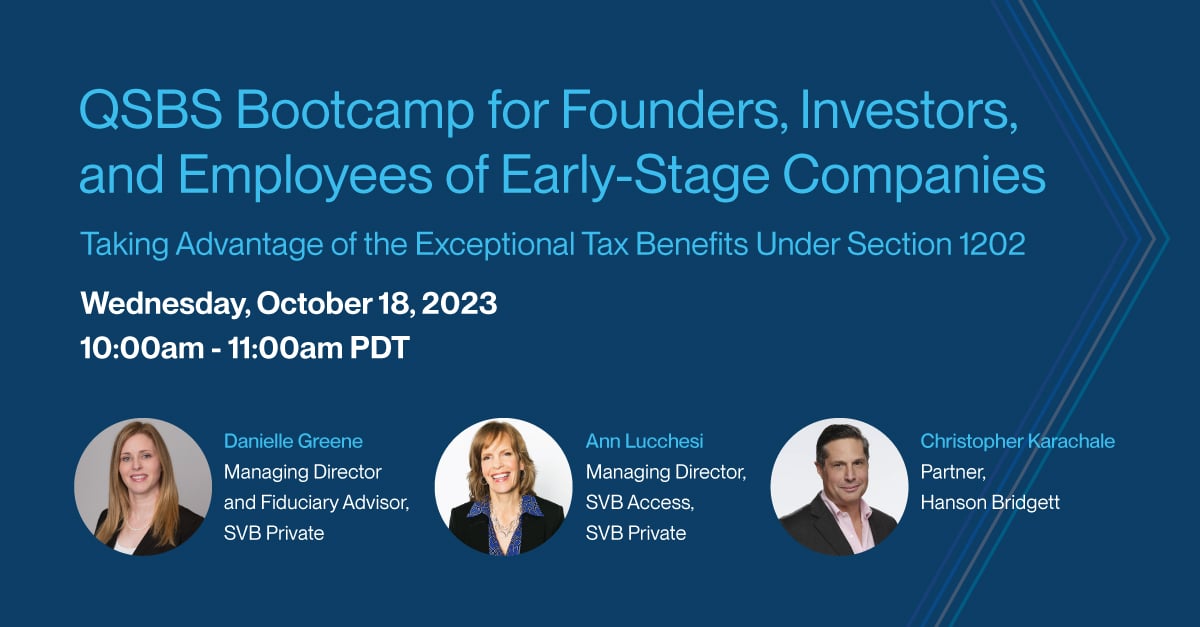Key takeaways
- By planning ahead while at a start-up, you can help minimize taxes and optimize liquidity by implementing a few key strategies.
- Understanding the implications of the Qualified Small Business Stock exemption can be one of the most valuable information you have regarding your shares and their tax implications.
- While you are likely not earning the same amount at a startup as you would at a job in a large company and your cash flow may be quite limited, there are ways that you can tap liquidity.
As a founder or executive at a startup company, you know that liquidity is key to your personal financial planning. You also likely know that taxes upon a liquidity event can be significant for a startup founder or executive, but you may not realize how all these details may impact you.
Strategies to maximize liquidity over the startup company’s life, while lowering tax exposure are often not fully understood or implemented by entrepreneurs. But, if done right, they can help reduce tax exposure on potentially millions of dollars while maximizing returns.
By taking a “peek around the corner” of a typical liquidity event, here’s how you can help minimize taxes and optimize liquidity by implementing a few key strategies.
How to help minimize taxes
There are three key ways to minimize taxes down the road, and they all have restrictions and time constraints. If you are early in the startup process, consider utilizing these strategies, as the benefits may be significant and realized over time.
1. QSBS exemption status
For founders and executives, understanding the implications of the Qualified Small Business Stock exemption can be the most valuable information you have regarding your shares and their tax implications. At a very high level, it can mean saving all federal income taxes on the first ten million in gains and depending on the state you are in, it may mean saving on state taxes as well. Given that the company’s structure at the time of share acquisition is a fundamental piece of this rule, entrepreneurs may want to have a discussion with their accountant prior to starting a company on the pros and cons of utilizing an LLC, S-Corp or C-Corp structure. For companies that were founded as an LLC, it may be worthwhile to consider transitioning to a C-Corp sooner to begin the qualification for QSBS which is not available to LLCs. Prior to any liquidity event it can be meaningful to take the time to have an accountant verify which shares on the cap table are eligible and when the 5-year holding mark has been met. It is also critical to understand some of the ways you may be able to extend the $10 million exemption through the use of trusts.
Case Study: Let’s say you founded a company and have 2 million shares that you own outright and 200,000 shares that you gifted to an irrevocable trust for your children and all of the shares have been owned for 6 years; however, the company was originally founded as an LLC and only converted to a C-Corp upon the A Round of funding 4 years ago. You have recently been approached by a large publicly traded company that would like to acquire the company for $10 per share. Unfortunately, if you sell the company for all cash, you will be subject to capital gains on the entire amount of the sale. However, since your shares are eligible for the QSBS exemption only after 5 years of ownership as a C-Corp, you are looking for an alternative to an all cash deal. As you confer with the buyer, you find they are willing to do the deal as a half cash and half stock deal. This could be a significant advantage to you from a tax point of view. Your cash portion of the sale will still be taxed at federal LTCG rates; however, assuming you hold the stock deal portion for 1 more year to tack to the 5-year holding requirement under QSBS, that portion will receive QSBS preferential treatment up to the price at the time of acquisition and LTC gains on any incremental gain. Additionally, the trust will receive QSBS preferential treatment on $1,000,000 as well, capped at the time of the acquisition and LTC gains on any incremental gain.
2. Founders Preferred Shares (Series FF shares)
Entrepreneurs may also want to consider utilizing Founders Preferred shares for some portion of their ownership. These types of common shares have a unique ability to convert to preferred upon sale, thereby allowing the founder to receive a preferred value for them. There are many pros and cons to utilizing these types of shares. While it can make it easier to get some liquidity in a secondary event, it may make it more difficult to get an initial round of funding from an institutional backer. It can also have an impact on 409(a) valuations as the company grows since these may be treated as a separate class of stock so it is important to understand the implications before opting to utilize them. They are most often used by repeat entrepreneurs who often have an easier time raising capital.
3. Utilizing the 83(b) election
Section 83(b) of the Internal Revenue Code allows property owners at significant risk of forfeiture to pay tax prior to the release of restrictions. This advantage can be significant for stock option holders who are able to early exercise their options. Exercising options prior to their vesting and filing an 83(b) election allows the holder to pay ordinary income tax on the spread between the strike price and the current 409a valuation at the time of exercise, rather than paying taxes later at the exercise/vest date on the theoretically increased spread. The significant upside to making this election is if the stock price continues to rise, you can save a large amount by shifting to long-term capital gains and away from ordinary income (currently a difference of 17% at the maximum federal income tax rates). The risk, of course, is that the value of the stocks may decline over time, resulting in a loss of principal and an overpayment of taxes. Most critical is that the 83(b) election must be made within 30 days of the option exercise (unvested shares only) and filed with the IRS. Simply put, it accelerates your ordinary income tax to the date of the exercise as opposed to the date of vesting when the value of the stock may have increased.
Case Study: Here’s how the 83(b) election might play out. You are granted 200,000 options with a grant price of $0.02 each and you immediately exercise the full grant, paying the $4,000 for the cost of the shares. You file for an 83(b) election within 30 days of the exercise and because the options were granted at the current fair market value, the implied gain is $0, so no tax is due. You are now free from paying tax until you sell the stock. Let’s assume the shares are worth $6.00 at the time of sale and you realize a capital gain of $1,196,000. If you had waited to exercise the shares until the time of sale, your federal ordinary income tax (at the highest bracket in 2020) would have been $442,520† plus NIIT, applicable social security and applicable state & local tax). By taking the 83(b) election your likely federal LTCG tax would be $239,200‡, thereby saving $203,320 in federal taxes.
In addition to the benefit of exercising early and taking an 83(b) election, entrepreneurs exercising shares that are eligible for QSBS can potentially pay no federal tax on those shares.
Optimizing liquidity
In addition to tax liabilities, you need to consider cash flow when exercising your options. While you are likely not earning the same amount at a startup as you would at a job in a large company and your cash flow may be quite limited, there are ways that you can tap liquidity.
These tools can generate cash without impacting your long-term liquidity goals:
- Take a loan from your company. These loans may be the most inexpensive but do use cash that you may otherwise wish to use for growing the business; however, if the loan is used for the purchase of options, the cash comes back to the company upon exercise.
- Ask your company to repurchase some of your shares. Note: Certain redemptions can potentially disqualify some purchases of stock from QSBS treatment. Specifically, redemptions in excess of 5% of the aggregate value of the corporation’s outstanding stock within one year (either before or after) of the purchase of stock will disqualify it from QSBS treatment.
- Access liquidity via the secondary market on a round raise, assuming the appetite of interested purchasers.
- Third party loans, these may be through banks or other types of lenders
- Liquidity through other assets owned, such as a home equity line or securities-based line of credit.
It is important to note that, depending on the manner in which you sell shares through a secondary transaction, the tax consequences can be drastically different. Generally, if the shares are being repurchased by the company at a price that exceeds the 409(a) valuation, the excess value over the 409(a) value is typically treated as ordinary income. Contrast this to selling the shares directly to a third party where the shares likely receive LTCG treatment. In both cases QSBS may be applicable and should be discussed with your CPA prior to the secondary event.
While the early stages of a startup may have limited liquidity opportunities, when you reach the mid-stage leading up to a liquidity event, it’s time to start thinking about your wealth in a new way. Again, as you peek around the corner to your event, consider how your future net worth is about to change — perhaps significantly — and you should consider planning around this liquidity and devise a full financial plan that supports your goals:
- Do you need to plan for family needs, such as private school, college and perhaps wedding?
- Are you prepared for future retirement? Often entrepreneurs overlook this but should take advantage of liquidity to put a plan in place.
- Will you be investing in other startups and or venture capital funds?
- Will you be starting a new company and are you prepared financially to take a reduced salary again?
Use these questions to ensure you’re considering significant future events when optimizing pre-event liquidity. This is the time to engage with a professional that understands the planning you need to put in place to be prepared.
IPO in the future?
The post-liquidity phase is all roses, right? While liquidity is now less of a concern, it’s still important to understand the many restrictions on liquidity that will come into play. First, you will need to contend with lockup restrictions which will typically restrict you from selling any shares for 6 months after the initial offering. Then there are the trading windows you will need to contend with, thereby limiting your liquidity to occasional times you can sell or require the implementation of a 10b5-1 plan. Finally, if you are deemed to be a Section 16 officer, all of your transactions will be filed publicly. This subjects you to increased scrutiny every time you sell and additional pressure to hold your shares.
While it’s impossible to predict exactly how your startup’s liquidity event will transpire, it’s important to consider certain future events and avoid unnecessary tax and cash flow pitfalls. SVB Private Bank is here, alongside your personal tax advisor and legal team to help you plan ahead to minimize tax liabilities and manage liquidity, no matter where you are in the process.
For more information on how to maximize liquidity and increase cash flow, see our articles at https://www.svb.com/private-bank/insights.














